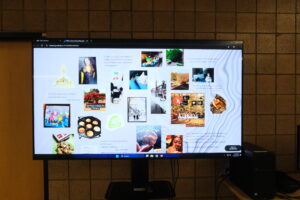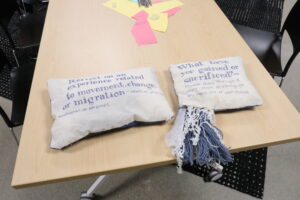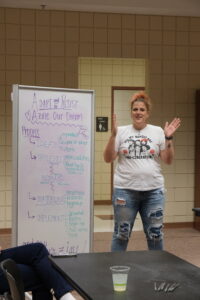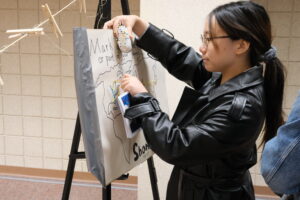a2ru Pilots Single-University Emerging Creatives Student Summit
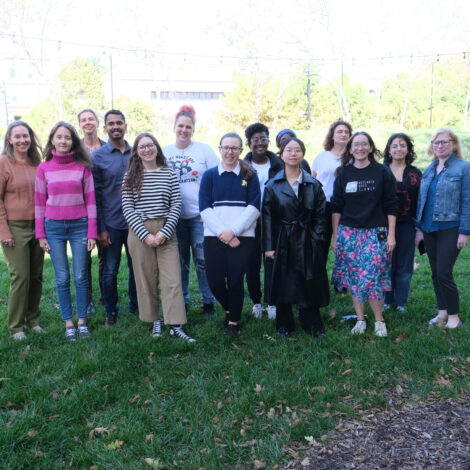
Oct 10, 2024
This month, a2ru piloted a single-university version of its popular Emerging Creatives Student Summit at its host institution the University of Michigan, supported by Engaged Michigan and the Vice Provost for Engaged Learning. “Migration” brought together students from U-M’s Ann Arbor and Dearborn campuses, representing a broad range of academic disciplines including Mechanical Engineering, Social Work, Neuroscience, Anthropology and Art and Design, for a weekend of collaborative inquiry where teams of students created arts-integrative projects responding to some aspect of the summit theme.
Veronica Stanich, a2ru Research Program Manager and the facilitator for Emerging Creatives, said of the experience: “I love this event because it gives students a framework within which they can come together with people from different fields to investigate an idea they’re all interested in. We really work on addressing the challenges that come along with working with people who may not share your assumptions, and it’s fun to see how these different perspectives ultimately come together in the students’ projects.” Throughout the event, Stanich provides short training sessions on interdisciplinary collaboration skills, along with individualized support for the student teams as their projects develop.
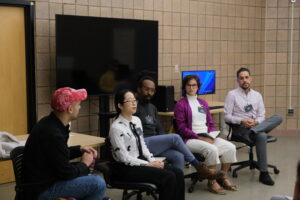 The event kicked off with a panel featuring scholars and artists from the University of Michigan whose research and creative practice engages with the concept of migration in some way. Moderated by Felix Zamora Gomez, Program Coordinator for Engagement with the U-M Arts Initiative, the panelists included Fangfei Miao, Assistant Professor of Dance, School of Music, Theatre and Dance; William Lopez, Clinical Assistant Professor, Health Behavior and Health Equity, School of Public Health; Angela Schopke Gonzalez, PhD Candidate, School of Information, and independent dance artist; and D. André Green, Assistant Professor of Ecology and Evolutionary Biology, College of Literature, Sciences and the Arts. The panelists discussed how the idea migration–of people, butterflies, information and art forms–informs their work; how to balance emotional and political investment in their work with well-being; and how the arts can be a powerful vehicle to improve communication and audience engagement across disciples.
The event kicked off with a panel featuring scholars and artists from the University of Michigan whose research and creative practice engages with the concept of migration in some way. Moderated by Felix Zamora Gomez, Program Coordinator for Engagement with the U-M Arts Initiative, the panelists included Fangfei Miao, Assistant Professor of Dance, School of Music, Theatre and Dance; William Lopez, Clinical Assistant Professor, Health Behavior and Health Equity, School of Public Health; Angela Schopke Gonzalez, PhD Candidate, School of Information, and independent dance artist; and D. André Green, Assistant Professor of Ecology and Evolutionary Biology, College of Literature, Sciences and the Arts. The panelists discussed how the idea migration–of people, butterflies, information and art forms–informs their work; how to balance emotional and political investment in their work with well-being; and how the arts can be a powerful vehicle to improve communication and audience engagement across disciples.
Before self-selecting into teams to begin work on their projects, students completed a photo essay exercise where they collectively created a series of photos taken on campus that spoke to elements of migration such as home, arrival, and travel. The photos were then hung to create a gallery in the students’ workspace for the weekend.
On the first day of the summit, the students also took a field trip to the University’s Matthei Botanical Gardens to learn about issues of migration and adaptation in the plant world and their implications for broader ecological issues. On a tour led by longtime Matthei educator Dorrie Milan, she highlighted specimens from the Matthei’s broad collection, including the banyan tree, which is able to move itself by its roots across an environment over time in order to maximize its access to resources and chance of survival.
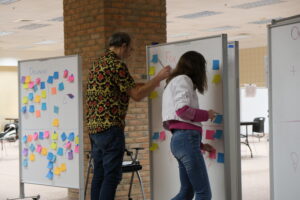 As the students prototyped their interdisciplinary projects on the second day of the summit, they participated in a structured feedback session where they received input from fellow students, a2ru staff, and faculty mentors from across U-M: Christianne Myers, Claribel Baird Halstead Collegiate Professor of Theatre & Drama; Rachel Niemer, Managing Director of Women in Science & Engineering and Lecturer in Education; and Mark Tucker, Art Director of the Lloyd Scholars in Writing and the Arts. Participants had an opportunity to process the feedback as a group and make a plan to prepare their projects for the final presentations to the group on the Summit’s third and final day.
As the students prototyped their interdisciplinary projects on the second day of the summit, they participated in a structured feedback session where they received input from fellow students, a2ru staff, and faculty mentors from across U-M: Christianne Myers, Claribel Baird Halstead Collegiate Professor of Theatre & Drama; Rachel Niemer, Managing Director of Women in Science & Engineering and Lecturer in Education; and Mark Tucker, Art Director of the Lloyd Scholars in Writing and the Arts. Participants had an opportunity to process the feedback as a group and make a plan to prepare their projects for the final presentations to the group on the Summit’s third and final day.
The students’ projects included:
- “What Comes Along/What Gets Left Behind,” a website featuring text, photography, and audio exploring the group’s personal experiences with migration; a companion analogue experience invited Emerging Creatives participants to write or draw about their own migrations or moves, which were then archived on the site.
- “Our Dream,” a zine exploring the personal and political implications of migration, haunted by the concept of the “American Dream.”
- “The Fox Den,” a pop-up installation exploring the concept of of a “third place,” offering facts about third places, ideas of potential third places to explore in Ann Arbor, a map where you could put a pin marking places you’ve called home, card games, and other activities.
Kelz Cousins, a Master of Social Work student, said of her Emerging Creatives experience: “Bringing together folx from different schools/departments across campus, degree levels, ethnicities, nationalities, ages, abilities, lived experiences, etc and focusing them on 1 topic, while also learning about group dynamics, processes and structure in order to create a beautiful end product that could not have been created in a homogenous environment was awe inspiring and transformative!” Talitha Tukura-Pam, a doctoral student in anthropology and history, added: “This is an opportunity to discover the exciting possibilities of what you can achieve with your research. You’ll be surrounded by people who don’t just politely find your work interesting—they genuinely believe that creative outputs are important!”
a2ru will continue to host an annual Emerging Creatives Student Summit in early spring for students from throughout the a2ru network; the announcement of the 2025 Emerging Creatives Student Summit will be made later this month. If you are interested in bringing a single-university Emerging Creatives to your campus, contact a2ru Associate Director Shannon Fitzsimons Moen at skfitz@umich.edu.
Photo Credit: Aryan Chaudhry

